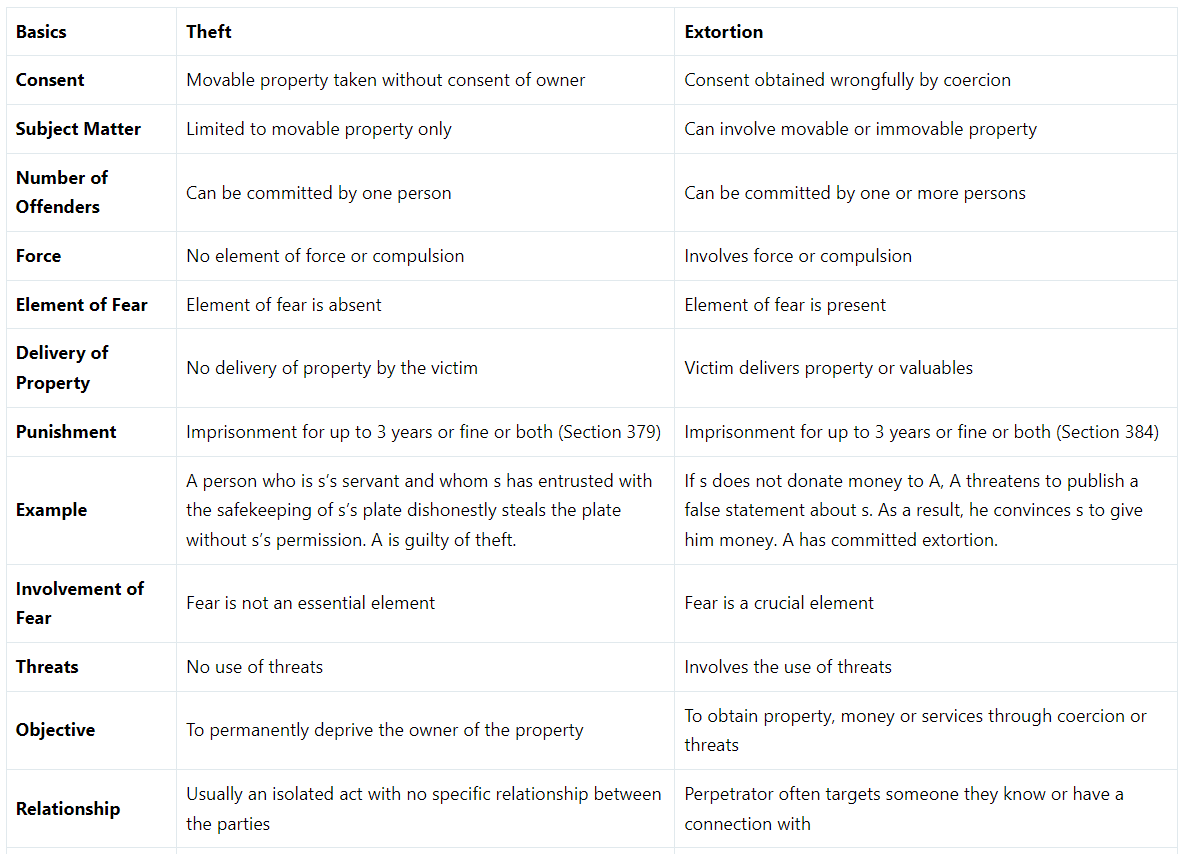Difference Between Theft and Extortion | Criminal Law for Judiciary Exams PDF Download
Introduction
- Property-related offenses are of great significance as per the Indian Penal Code (IPC), specifically detailed in Chapter XVII from Sections 378 to 462. Within this domain, Theft and extortion stand out as distinct and captivating acts.
- Theft and extortion, despite both involving property, differ fundamentally in terms of consent and the methodologies used to acquire the property. Theft involves the unauthorized taking of someone's property without their consent, whereas extortion relies on intimidation and threats to compel the victim into compliance.
Explaining Theft and Extortion
- Theft: Involves the act of unlawfully taking someone's property without their permission. For example, if someone steals a mobile phone from a parked car, it constitutes theft as the action was done without the owner's consent.
- Extortion: Involves obtaining property or money through coercion or intimidation. An example would be threatening to harm someone unless they give you money. The crucial aspect here is the use of fear to extract property or money.
Key Differences Between Theft and Extortion
- Consent: Theft occurs without the victim's consent, while extortion involves taking property with the victim's apparent agreement due to coercion.
- Methodology: Theft relies on stealth or secrecy to take possession of property, while extortion employs threats, coercion, or force to obtain the property.
Definition of Theft and Extortion
Theft
- Theft, as per Section 378 of the Indian Penal Code, is identified as a crime against property, involving the dishonest taking of movable property without consent.
- The crucial aspect defining Theft is the intentional and dishonest act of removing movable property without permission.
- It is important to note that Theft does not involve sharing stolen goods for public benefit.
- Explicit or implicit consent plays a role in determining Theft, but a belief of entitlement, without permission, does not constitute Theft.
- Examples:
- Rahul committed Theft when he took Ajay's watch without consent and with malicious intent.
- Hemant engaged in criminal misappropriation by selling a found ring without the owner's permission.
Extortion
- Extortion, defined under Section 383 of the Indian Penal Code, involves using threats to compel someone to provide goods, money, or services without receiving anything in return.
- The perpetrator induces fear in the victim to obtain valuable assets like cash, property, or services.
- Central to extortion is the unjust intention to harm one person while benefiting another.
- Examples:
- A extorts money from S by threatening to publish false damaging information about S.
- A engages in extortion by threatening to harm S's child unless S signs a promissory note.
Understanding Theft and Extortion
Theft
- Dishonest Intention: To commit theft, one must have the intention to wrongfully gain property or cause wrongful loss to another individual. Simply taking someone else's property while pretending it is your own does not qualify as theft.
- Movable Property: Theft involves property that is movable in nature. Immovable property attached to the ground does not fall under theft unless it is severed from the earth.
- Removal from Possession: The property must be taken from another person's possession. Taking property from someone who already legally possesses it is not considered theft.
- Without Permission: Theft occurs when property is taken without the consent of the person who possesses it. If the owner willingly gives permission, it is not considered theft.
- Act of Taking: Some action must be involved in taking the property for theft to occur. The property must be moved or taken in some manner.
In a legal context, the case of M/s Shriram Transport Finance Co., Ltd. v. R. Khaishiullah Khan (1992) clarified that the seizure of property by a financer after a default on a hire purchase agreement does not constitute theft as the financer has the right to do so. Similarly, in the case of Venkat Narayan v. State (1976), it was established that evidence of dishonest intent is crucial to prove guilt in a theft case.
Extortion
- Intentional Fear Inducement: Extortion involves intentionally causing fear in a victim of immediate injury, death, or wrongful restraint to obtain property or valuable security.
- Intent: The offender must have the intention to commit extortion by using threats to coerce the victim into surrendering property or valuable security.
- Property Delivery: The aim of extortion is to obtain property or valuable security from the victim as a result of the threat made.
For an act to be considered extortion, the threat must be severe enough to eliminate the victim's free will and ability to provide consent. This threat can extend beyond physical harm to include harm to possessions, reputation, or mental well-being. According to Section 44 of the Indian Penal Code, "injury" encompasses any unlawful harm to a person's body, mind, reputation, or property. Threats of divine punishment do not qualify as harm in cases of extortion.
Punishment for Theft and Extortion
Theft
- The penalties for theft offenses in India are governed by Sections 379 to 382 of the Indian Penal Code, with varying punishments based on the circumstances.
- Theft (Section 379): Punishment for theft includes imprisonment for up to three years, a fine, or both.
- Theft in Dwelling Houses (Section 380): Stealing from a place where people live or store property can lead to imprisonment for over seven years and a fine.
- Theft by Servant (Section 381): If a servant steals from their employer, they may face up to seven years of imprisonment and a fine.
- Theft involving preparations for harm (Section 382): Planning to cause harm while committing theft can result in rigorous imprisonment for up to ten years and a fine.
Extortion
- Section 384: Extortion carries a minimum penalty of three years in prison, a fine, or both.
- Section 385: Attempting to instill fear for extortion purposes may lead to up to two years in prison, a fine, or both.
- Section 386: Extortion through fear of severe consequences can result in imprisonment for up to ten years and a fine.
- Section 387: Extortion by threatening grievous harm or death can lead to imprisonment for up to seven years and a fine.
- Section 388: Threatening false accusations for extortion may result in a life sentence or the death penalty.
- Section 389: Attempted extortion through false accusations carries a life sentence or the death penalty.
These sections of the Indian Penal Code address theft and extortion with varying degrees of severity, ensuring appropriate penalties based on the offense committed.
Classification of Criminal Offenses
Theft
- Cognizable: This indicates that the police have the power to arrest the accused without a warrant if they have reasonable grounds to suspect a theft has occurred.
- Non-bailable: This signifies that a person accused of Theft cannot be automatically granted bail. Bail may be allowed at the court's discretion but is not a guaranteed right.
- Triable by any magistrate: Any magistrate, regardless of jurisdiction, can preside over and decide cases of Theft.
Extortion
- Triable by any magistrate: Extortion cases can be heard and settled by any magistrate, irrespective of their jurisdiction.
- Non-bailable: Similar to Theft, extortion is a non-bailable offense, and bail can be given at the court's discretion.
- Compoundable: In contrast to Theft, extortion is a compoundable offense, allowing the victim and accused to reach a settlement. The victim can withdraw the case with the court's approval.
Difference Between Theft and Extortion
Theft and extortion, both categorized as crimes against property, exhibit distinctions in several aspects. The differences between theft and extortion include the following points:
- Definition: Theft involves dishonestly taking someone's movable property without their consent, intending to permanently deprive them of it. In contrast, extortion is the act of acquiring property, money, or services from someone through threats, coercion, or intimidation.
- Nature: Theft constitutes a crime against property, while extortion is a violation of property rights and personal liberty.
- Type of Property: In Theft, only movable properties are targeted, whereas in extortion, victims may surrender both movable and immovable properties to avert potential harm.
- Consent: In Theft, the victim does not consent to the taking of their property. However, in extortion, the victim may relinquish their property or valuables under duress or fear.
- Intent: The primary objective of Theft is to unlawfully take and permanently deprive the owner of their property. Conversely, extortion aims to secure property or valuables using fear or intimidation.
- Presence of Threat: Theft does not involve threats or coercion towards the victim. On the contrary, extortion relies on threats or intimidation to compel the victim to comply.
- Subject Matter: While Theft is confined to the appropriation of movable property, extortion can encompass both movable and immovable property.
- Number of Offenders: Theft can be perpetrated by a single individual, whereas extortion may involve one or more persons acting together.
- Force: Theft does not entail the use of force or compulsion. Conversely, in extortion, force or compulsion is present as victims are threatened with injury.
- Element of Fear: In Theft, fear is absent as the act is committed without instilling fear in the victim. In contrast, extortion involves fear, with perpetrators using threats or coercion for compliance.
- Delivery of Property: In Theft, victims are not required to voluntarily deliver their property. However, in extortion, victims surrender property or valuables to evade threatened harm.
- Punishment: Both Theft and extortion are punishable by imprisonment for up to 3 years, a fine, or both, as outlined in the Indian Penal Code.
- Relationship: Theft is typically an isolated act with no specific relationship between the perpetrator and the victim. In contrast, extortion often targets individuals with whom the perpetrator has a connection.
- Level of Harm: While Theft primarily results in property loss, extortion inflicts broader harm, including fear, psychological distress, and potential physical harm on the victim.
- Criminal Elements: Theft involves taking property without consent, whereas extortion incorporates threats or coercion to compel compliance with the perpetrator's demands.
Key Differences Between Theft and Extortion


Conclusion
- In conclusion, the distinctions between theft and extortion are substantial. Theft encompasses the dishonest appropriation of movable property without the owner's consent, while extortion involves obtaining property, money, or services through coercion and threats. Variances in intent, the presence of fear, the transfer of property, the application of force, and the element of consent differentiate these two offenses.
- The act of theft is characterized as an isolated event without the use of force or intimidation, whereas extortion relies on intimidation to compel compliance. Furthermore, extortion can encompass both movable and immovable property, whereas theft is confined to movable property.
|
104 docs|69 tests
|
FAQs on Difference Between Theft and Extortion - Criminal Law for Judiciary Exams
| 1. What is the key difference between theft and extortion? |  |
| 2. What is the punishment for theft and extortion? |  |
| 3. How are theft and extortion classified as criminal offenses? |  |
| 4. Can theft and extortion be charged together in the same case? |  |
| 5. What should someone do if they are a victim of theft or extortion? |  |
















